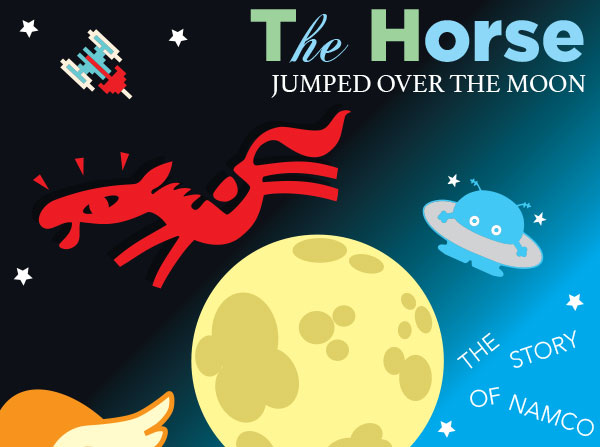
In the previous blog I talked about The Tower of Druaga, one of the two games that Namco had turned into an attraction at the Expo ’90 in Osaka Japan. The company felt that the Expo ’85 organizers in Tsukuba, Ibaraki Japan did a disservice to the company. They decided to go all-out and create an entirely new type of attraction for the “Magical Cross” amusement area in Osaka. It would be something completely different from the roller coaster, carousel, or Ferris wheel at the park. In fact the company considered what they were building to be something different from what was available in amusement parks, or even theme parks. They called their attractions “Hyper Entertainment.” Unlike most amusement rides where the audience were passive the Namco attractions promised to put the rider in the role of the hero. They would be challenged in different ways every time they rode.
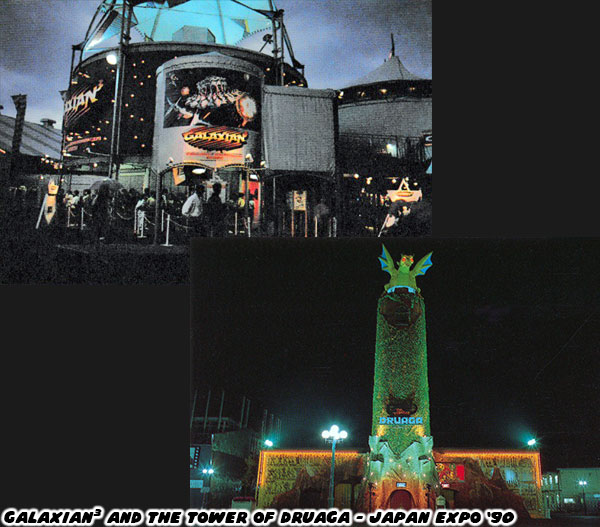
Akatsuki Kogei was in charge of planning and directing the Tower of Druaga. He had to find the key elements of the three games of
the Babylonian Castle Saga. At the time those were the Tower of Druaga, The Return of Ishtar, and The Quest of Ki. The other eight titles in the series hadn’t come out yet. What were the elements that went into the game? What did audiences remember about the experience, and what highlights could be turned into tangible scenes for an attraction? It was clear who the heroes, and main villain would be, but what about the various enemy types introduced in the games? How would 2D sprites look in a 3D environment?
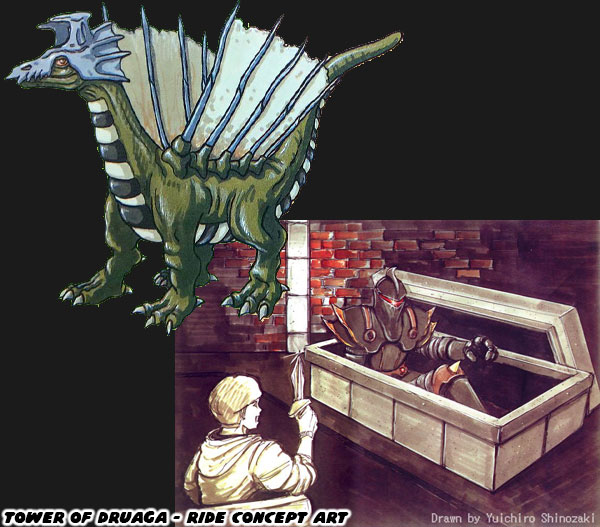
Despite being a video game Namco made sure that when audiences thought of the Tower of Druaga they imagined it as a physical location. They wanted audiences to think that the story happened in a real place, and time. This came through in the original poster for the game. Rather than create a fantastic rendering Namco artist Yuichiro Shinozaki combined physical models, with paintings of the cast. It was presented in a western comic book format, going so far as to feature word balloons in English. This was rare for Japanese game flyers. It explained how to play the game, and even how to approach some of the different enemy types. This advertisement highlighted the western influence of the game. The use of painted miniatures owed a lot to classic tabletop systems such as Dungeons & Dragons by TSR, but also Warhammer Fantasy Battle by Games Workshop. Namco would eventually release novels, and role-playing supplements, as well as a board game based on the Tower of Druaga in Japan. They also released board games for Pac-Man, Xevious, and their other hits. For many kids in Japan this was their first introduction to traditional tabletop RPGs.
Aurora Models even released a series of miniatures to celebrate 40 years of Druaga.
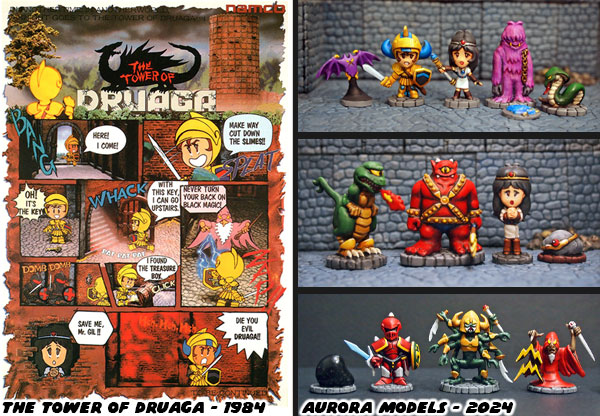
Mr. Kogei knew that the sets, animatronics, and location had to have an ancient western feel, and not a Japanese look. Mr. Shinozaki worked on the concept art for the various scenes in the attraction. Making sure that it felt as authentic as possible to the original game. The team had to figure out how to pace the experience, and put the audience in the role of Gilgamesh, the hero. The arcade hit was known for being difficult. It was credited for establishing “notebook carrying” games. In Japan the most dedicated players would map everything they found in notebooks, including layouts of the various floors in the game. Mind you this was before the home version was released. These notebooks predated game guides published by the studios, or game magazines.
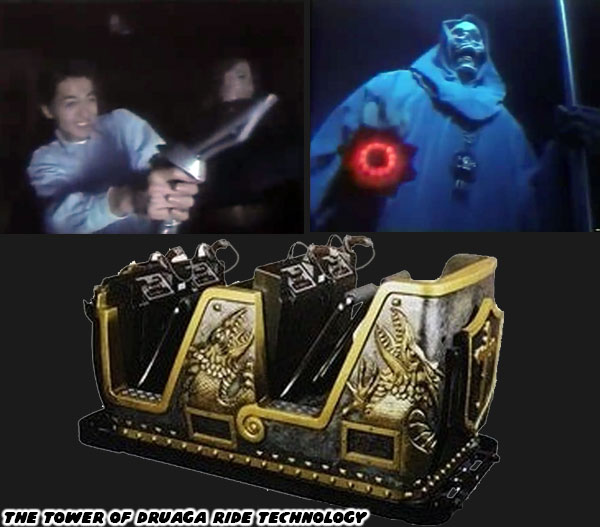
The goal for Mr. Kogei, and his team was create an attraction that was “the first role-playing game ride with multiple scenarios and multiple endings.” Up to 4 players at a time would ride in armored carts, as they made their way through the tower. Players used a light gun, which was shaped like Gil’s sword against against all sorts of monsters, and demons. The actual length of the attraction, and score was determined by which targets you hit, and when you hit them, rather than just blasting everything. Audiences had to listen to their opponents carefully, as well as watch for clues during the ride. You could earn “treasure,” or rather clues on each opponents weaknesses as you progressed through the various rooms. Regular scores earned a Bronze ending, and the ride went right to the exit. If you paid attention to hints, the ride went a bit further and featured a battle with a dragon. Players that managed to defeat the dragon earned a Silver ending, and then the ride was over. If you defeated the dragon, and then Druaga then you got the Gold ending. This meant that you would reach, and rescue Kai before exiting the ride.
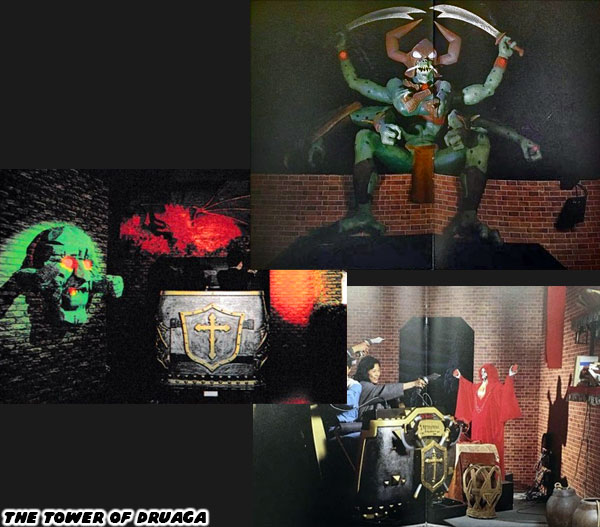
Those that played through the attraction would say how fun it was, but also that it was indeed difficult. Namco certainly understood that the people that were raised on arcade experiences were getting older, and looking forward to the evolution of the format. The Tower of Druaga not only predicted, but also predated the Disney attractions such as Buzz Lightyear’s Space Ranger Spin by 8 years, Toy Story Midway Mania by 16 years, and Web Slingers A Spider-Man Adventure by 31 years. Can you imagine how much fun Pirates of the Caribbean would be if you could shoot back at the various scenes in the attraction, earn a longer ride, and perhaps a treasure at the end?
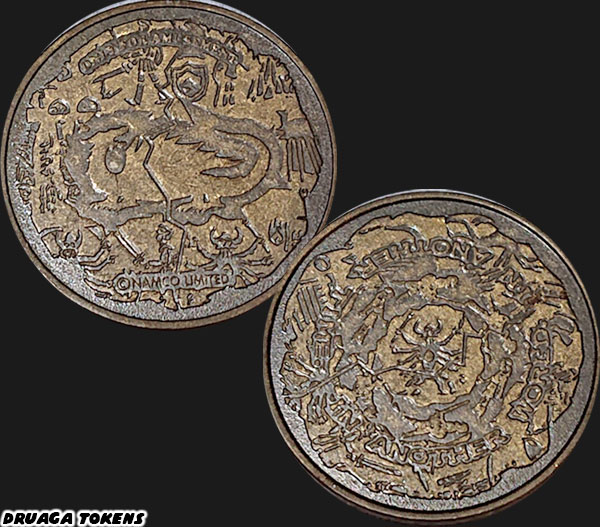
Namco partnered up with coaster manufacturer
Togo for the ride system. Togo had been in business longer than Namco, and had a great reputation in Japan for their roller coasters. Their joint venture was called N&T, and was designed to create the next generation of amusement attractions, and amusement parks. With the Tower of Druaga pulling guests 4000 years into the past, the next featured attraction from Namco would send them centuries into the future. We will look at this attraction in the next blog. If you were a fan of the Babylonian Castle Series then I’d like to read about it in the comments section. As always if you would like to sponsor me
please visit my Patreon page and consider donating each month, even as little as $1 would help make better blogs and even podcasts!
Wonder Eggs, and Egg Empire research collected from: Wonder Eggs Guide Map, Namco Graffiti magazine, the book “All About Namco II", NOURS magazine, The Namco Museum, Namco Wiki, Ge-Yume Area 51 Shigeki Toyama Collection, mcSister magazine, first person attraction details from Yoshiki. Event details from Hole in the Socks














No comments:
Post a Comment